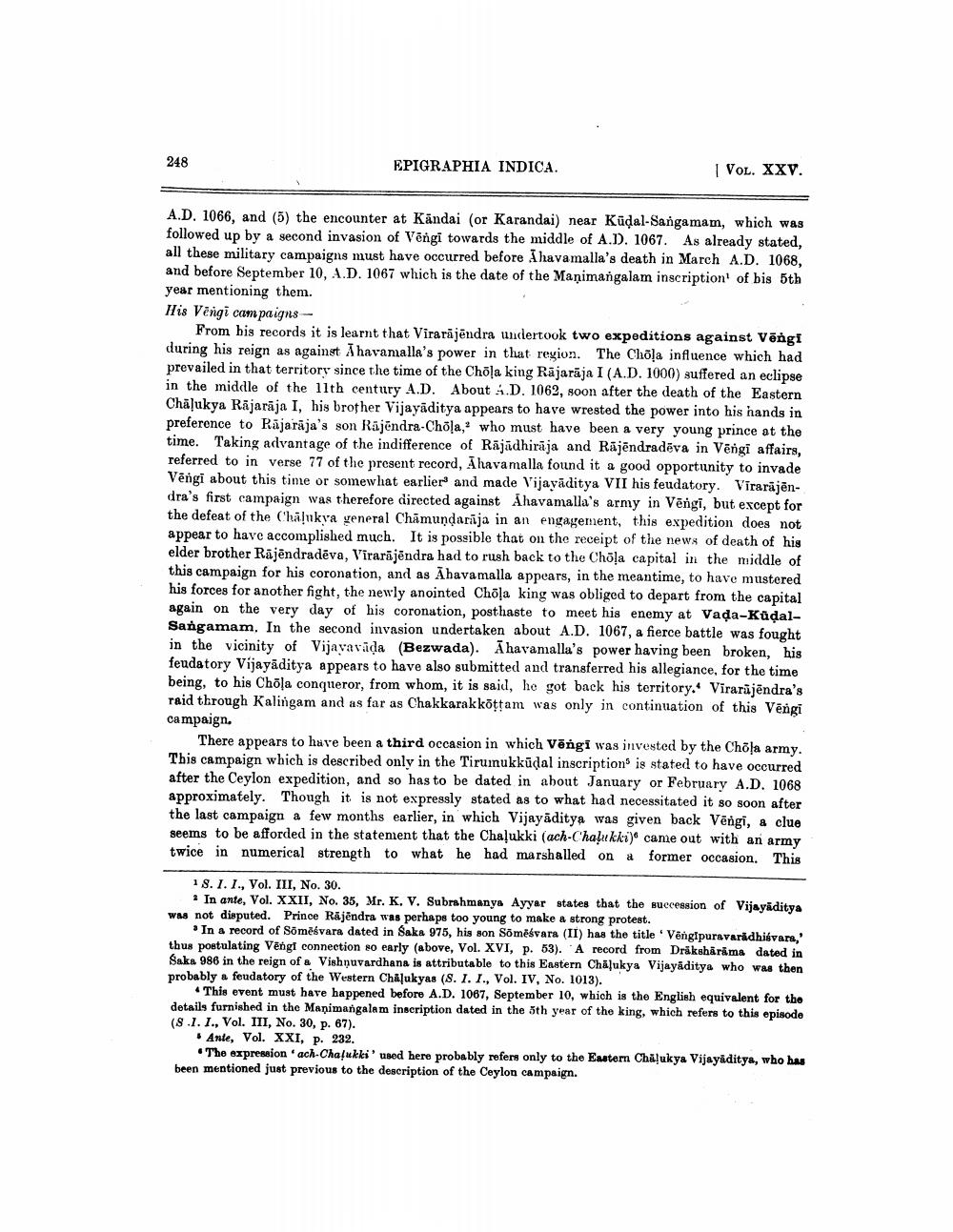________________
248
EPIGRAPHIA INDICA.
| Vol. XXV.
A.D. 1066, and (5) the encounter at Kändai (or Karandai) near Kūčal-Sangamam, which was followed up by a second invasion of Vēngi towards the middle of A.D. 1067. As already stated, all these military campaigns must have occurred before I hava malla's death in March A.D. 1068, and before September 10, A.D. 1067 which is the date of the Manimangalam inscription of bis 5th year mentioning them. His Vangi campaigns -
From his records it is learnt that Virarājēndra undertook two expeditions against Vēngi during his reign as against Ahavamalla's power in that region. The Chola influence which had prevailed in that territory since the time of the Chõļa king Rājarāja I (A.D. 1000) suffered an eclipse in the middle of the 19th century A.D. About A.D. 1062, soon after the death of the Eastern Chāļukya Rājarāja I, his brother Vijayāditya appears to have wrested the power into his hands in preference to Rajaraja's son Rajendra-Chola, who must have been a very young prince at the time. Taking advantage of the indifference of Rājādhiraja and Rājēndradēva in Vengi affairs, referred to in verse 77 of the present record, Ahavamalla found it a good opportunity to invade Vēngi about this time or somewhat earlier and made Vijayāditya VII his feudatory. Virarājēndra's first campaign was therefore directed against Ahavamalla's army in Vēngi, but except for the defeat of the C'halukva general Chamundarīja in an engagement, this expedition does not appear to have accomplished much. It is possible that on the receipt of the news of death of his elder brother Rajendradēva, Virarājēndra had to rush back to the Chöļa capital in the middle of this campaign for his coronation, and as Āhavamalla appears, in the meantime, to have mustered his forces for another fight, the newly anointed Chõļa king was obliged to depart from the capital again on the very day of his coronation, posthaste to meet his enemy at Vada-KudalSangamam. In the second invasion undertaken about A.D. 1067, a fierce battle was fought in the vicinity of Vijavavāda (Bezwada). Ahavamalla's power having been broken, his feudatory Vijayāditya appears to have also submitted and transferred his allegiance, for the time being, to his Chõla conqueror, from whom, it is said, ho got back his territory.. Virarājēndra's raid through Kalingam and as far as Chakkarakkottam was only in continuation of this Vēngi campaign.
There appears to have been a third occasion in which Vēngi was invested by the Chola army. This campaign which is described only in the Tirumukkūdal inscription is stated to have occurred after the Ceylon expedition, and so has to be dated in about January or February A.D. 1068 approximately. Though it is not expressly stated as to what had necessitated it so soon after the last campaign a few months earlier, in which Vijayāditya was given back Vēngi, a clue seems to be afforded in the statement that the Chaļukki (ach-Chalukka) came out with an army twice in numerical strength to what he had marshalled on a former occasion. This
18.1.I., Vol. III, No. 30.
In ante, Vol. XXII, No. 35, Mr. K. V. Subrahmanya Ayyar states that the succession of Vijayaditya was not disputed. Prince Rajendra was perhaps too young to make a strong protest.
In a record of Somēśvara dated in Saka 975, his son Soměsvara (II) has the title 'Vengipuravaridhisvara, thus postulating Vêng connection so early (above, Vol. XVI, p. 53). "A record from Drakshārams dated in gak 988 in the reign of a Vishnuvardhana is attributable to this Eastern Chilukya Vijayaditya who was then probably a feudatory of the Western Chalukyas (S.I. I., Vol. IV, No. 1013).
• This event must have happened before A.D. 1067, September 10, which is the English equivalent for the details furnished in the Manimangalam inscription dated in the 5th year of the king, which refers to this episode (8.1. I., Vol. III, No. 30, p. 67).
Ante, Vol. XXI, p. 232.
• The expression ach-Chalukki' used here probably refers only to the Eastern Chalukya Vijayaditya, who has been mentioned just previous to the description of the Ceylon campaign.




